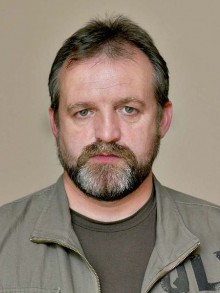Professional photographer Borys Korpusenko in his photos strives to capture and embody a meaningful semantics, or even an ideological concept. At the last year’s 16th International Den’s Photo Exhibition, his work On the Watch has won the prize of the National Mining University, and the Descendant, another work of his, was noted by Ivan Franko Lviv National University. The Day talks with Borys Korpusenko on the history of photos, on the attitude towards the depicted, and on the lessons of the past and present.
Last year you spent a lot of time on Maidan in order to capture the dramatic moments of our history on film. And the working conditions for journalists, including photographers were difficult. There have been reports on the beatings of journalists, as well as on the harassment for professional activity. More than half a year after the Revolution of Dignity, the center of Kyiv – its governmental quarter – is explosive again, in the literal sense...
“I believe that people should express their opinion and position; they should go to the protests, but never to resort to radicalism. One can express disagreement, one can bring banners – but not grenades, as innocent would suffer. It turns out that it is necessary to deal with an enemy within, because we have not only the external one. Without it, no real victory can be achieved. It happened that on August 31, I was in another place, and I didn’t film the clashes near the Parliament, but I can still feel the impact of these events. As it was during the Maidan events, the center of the peaceful capital is a dangerous place to work.”
Your photo On the Watch may serve as a symbolic illustration on the heroism of the National Guard soldiers who were killed on duty on August 31...
“Yes, I too consider this photo of a soldier on guard to be symbolic. I always capture the border control of the police officers at ceremonies of commemoration – for example, on May 9, or on the day the war began. Said photo is from that series. It presents such a sharp contrast of a red cockade against the gray sky. I was struck by the soldier’s endurance and equanimity – the person was on duty. It is the only way to ensure order.”
And what were the circumstances of the Descendant, which was also favored by the audience at the Den’s Photo Exhibition?
“It was made in one of the days on Maidan, when the shooting has already begun. Those who had the opportunity wore real helmets – not the construction ones, but military. In the crowd I saw a man who was wearing something very odd on his head. It was a helmet of the World War II. I was impressed by the eyes of this man – such as if he wants to shield everyone else with himself. It seemed that I was inside a movie, not in the actual events. The photo is symbolic and dramatic. I hope the helmet defended him.
“I believe that a photo should tell a true story. A photo transmits a piece of reality where people, objects speak for themselves. That reality, similarly to a written word, is able to kill and revive. I am convinced that photography in the first place should be meaningful, and the geometry and composition are secondary to the semantics. If it happens that the form and the contents match, then comes a masterpiece. This is the moment of creation, when a certain philosophy is captured on the photo.”
Will you submit your work to the next year’s Photo Contest?
“Of course! I want to thank Den and personally Larysa Ivshyna, the editor-in-chief, for hosting this significant event in the Ukrainian artistic life. There are various well-known photo contests, but they are held in Europe. This one is ours, and for that I am grateful. This is an event that grows each year since its inception, and everyone waits for it – both the photographers and the audience. Thanks to Den, the best photographers have the opportunity to exhibit their work, their achievements for the year. My personal history of the participation in the Contest began in 2006. Back then, my work has won the Grand Prix. That same year, Andrii Shevchenko has won one of the highest football awards – the European Champions’ Cup, and brought it home, to Kyiv. Then I thought that I am also a champion – in photography. I turned to Ivshyna with the proposal of the exhibition tour to my native village near Vinnytsia. It was a noble idea… everyone made fun of. But thanks to Den, the best photos of Ukraine are exhibited in Chechelnyk.”









